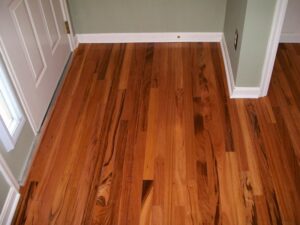When you’re planning a new floor, it’s easy to get caught up in colors, textures, and styles. But once the planks or tiles are chosen, a common question comes up: do you need flooring underlayment? This is where many homeowners and renovators hesitate, unsure if it’s essential or just an extra expense.
The truth is, underlayment can make a significant difference in comfort, durability, and even how your floor looks over time. From reducing noise to protecting against moisture, it plays a hidden but important role in the performance of your flooring. Understanding what it does and when it’s required can save you costly mistakes later.
Understanding Flooring Underlayment
Flooring underlayment is a thin layer installed between the subfloor and the finished flooring. While it may seem like a small addition compared to the visible surface, it plays a vital role in overall performance.
Underlayment provides cushioning underfoot, absorbs minor impacts, and helps level out small imperfections in the subfloor. This not only makes walking more comfortable but also reduces stress on the flooring material, enhancing its longevity.
The benefits go beyond comfort. Underlayment can reduce noise, add thermal insulation, and in some cases act as a barrier against moisture. However, it is not a one-size-fits-all solution.
Some flooring products, such as certain luxury vinyl planks, come with pre-attached padding, while others, like laminate, typically require a separate underlayment.
Choosing the correct type ensures your flooring is properly supported without unnecessary expense. Knowing the role underlayment plays helps homeowners make smarter decisions that protect both the look and durability of their floors.
Flooring Underlayment Types and Their Uses
There are several flooring underlayment types available, and each serves a distinct purpose depending on the flooring material and installation needs. Foam underlayment, for instance, is widely used with floating floors because it provides a light cushion, reduces sound, and smooths out minor imperfections in the subfloor.
Cork underlayment is a popular choice in multi-level homes and apartments, as it not only absorbs noise but also offers natural thermal insulation, keeping rooms more comfortable year-round.
Rubber-based underlayment delivers extra durability and moisture resistance, making it ideal for kitchens, basements, or other areas that may be exposed to water. Felt underlayment is another option often used with engineered wood, as it provides a firm base that improves stability and reduces squeaks. Some premium products combine multiple features, offering sound reduction, cushioning, and vapor barriers all in one.
The type you choose depends on your flooring material, the location of installation, and whether issues like moisture, insulation, or noise control are a concern. Selecting the right underlayment type ensures your floor not only looks great on the surface but also performs reliably in everyday use.

Best Underlayment for Laminate Floors
Laminate is one of the most common flooring materials that benefits from underlayment. Laminate planks are typically installed as floating floors, meaning they sit on top of the underlayment rather than being glued down. This makes the layer beneath them crucial for both comfort and durability.
The best underlayment for laminate floors is one that balances cushioning, sound reduction, and moisture protection. Foam with a built-in vapor barrier is a popular choice, as it not only softens the feel underfoot but also safeguards the planks from potential water damage. Using the right underlayment helps prevent hollow sounds and extends the life of your laminate.
Underlayment for Vinyl Plank Flooring
Vinyl flooring has grown in popularity for its resilience and realistic look. Some luxury vinyl planks come with an attached underlayment, but others may need an additional layer depending on the subfloor and installation method.
When choosing underlayment for vinyl plank, moisture control is especially important. A thin, dense underlayment works best, offering stability without creating too much flexibility. If you’re installing over concrete, a moisture barrier is essential to prevent water seepage from damaging your flooring.
Moisture Barrier Underlayment and Why It Matters
Moisture is one of the most damaging elements for any type of flooring. A moisture barrier underlayment creates a protective layer that prevents water vapor from seeping up through the subfloor, which is especially important in basements, ground-level spaces, and concrete installations.
By blocking this hidden moisture, it protects flooring from gradual damage that might not be visible until it’s too late. Without this protection, floors are at risk of warping, swelling, or even developing mold and mildew over time.
These issues not only shorten the lifespan of the floor but can also impact the indoor air quality of your home. The right moisture barrier underlayment adds an extra safeguard, giving peace of mind that your investment is protected from the ground up.
Even if a flooring product is labeled as water-resistant, pairing it with a moisture barrier underlayment provides a higher level of protection, ensuring long-term stability and durability.
Underlayment Thickness Guide for Different Floors
Thickness plays a critical role in how well your flooring underlayment performs. Too thin, and it may not provide enough cushioning or noise reduction. Too thick, and it can cause instability, prevent planks from locking properly, or make flooring connections less secure.
A general underlayment thickness guide suggests that laminate usually benefits from 2–3 millimeters, offering a balance of comfort and sound control. Vinyl planks, on the other hand, require a thinner option, around 1 millimeter, to maintain stability while still providing a moisture barrier.
Cork underlayment is often thicker, ranging from 4–6 millimeters, and is valued for its excellent sound absorption and thermal insulation, making it popular in multi-level homes or apartments.
For engineered wood, thickness depends largely on the installation method. Floating floors may use a thinner foam or cork underlayment, while glued-down options often require only a vapor barrier.
Understanding these variations ensures you don’t over- or under-compensate, which could shorten the lifespan of your flooring. Matching the right thickness with your flooring type not only improves performance but also helps avoid long-term issues such as warping, hollow sounds, or excessive movement.
Do I Need Underlayment for My Home?
Not every project requires underlayment, but many benefit from it. If your flooring already has padding attached, adding another layer may be unnecessary and even harmful. On the other hand, if you’re installing over concrete, wood, or an uneven surface, underlayment can help protect your floor and improve comfort.
Asking “do I need underlayment?” depends on the flooring material, subfloor condition, and location in your home. Taking time to evaluate these factors prevents wasted money and ensures your floors look and feel their best.
Conclusion
Choosing the right underlayment is about more than just following instructions on a box; it’s about protecting your flooring investment and making your home more comfortable. Whether you’re dealing with laminate, vinyl, or engineered wood, the right choice beneath the surface can make all the difference in how your floors perform.
If you’re planning a flooring project in Dubai and want professional guidance, Floor Guys can help. Our team understands the local climate and the challenges it brings, ensuring your floors are not only beautiful but built to last. Visit Floor-Guys.com today to learn more about our flooring services and book your consultation.
Frequently Asked Questions
How does underlayment help with soundproofing?
Underlayment reduces the noise created when walking across hard floors. It absorbs impact sounds, prevents echo, and creates a quieter indoor environment. This is especially useful in multi-story homes or apartments where footsteps easily carry through the structure.
Can underlayment improve insulation?
Yes, some underlayment materials like cork and rubber provide added thermal insulation. This helps maintain consistent indoor temperatures and makes floors feel warmer underfoot, particularly in cooler seasons. It adds both comfort and energy efficiency to your flooring system.
Is underlayment reusable when replacing floors?
Most underlayment is not designed to be reused. Once flooring is removed, the material often shows wear, compression, or damage. For the best results, it’s recommended to install fresh underlayment with each new flooring project to ensure proper performance.
Does underlayment work on uneven subfloors?
Underlayment can help smooth out minor imperfections, but it is not a solution for highly uneven surfaces. Significant dips or cracks in a subfloor must be repaired before installation. Proper preparation prevents long-term damage and ensures your flooring remains stable.
What is the difference between attached and separate underlayment?
Attached underlayment comes pre-bonded to flooring planks, eliminating the need for a separate layer. Separate underlayment is installed as its own layer beneath the flooring. The choice depends on the flooring product and the specific requirements of your space.






